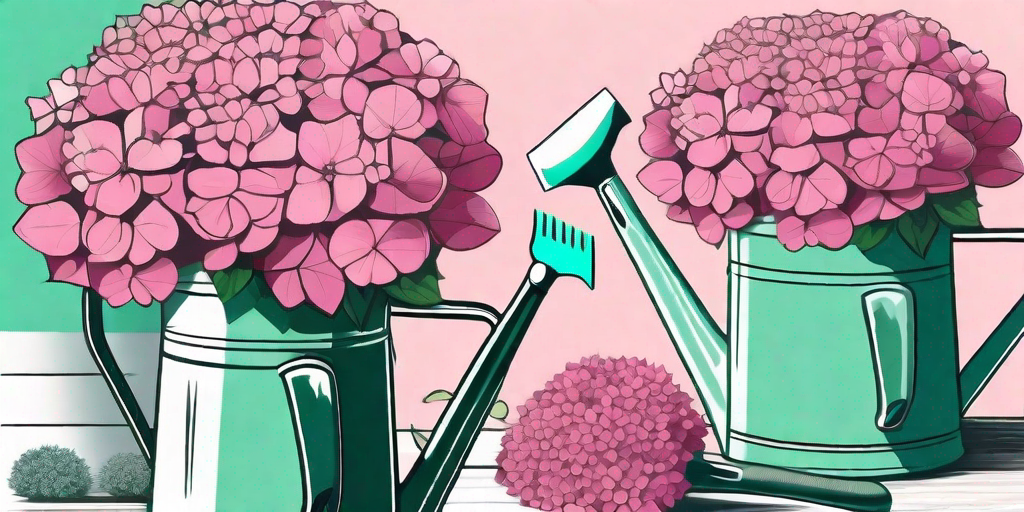
Welcome to the world of pink hydrangeas, where the blush of the blooms is only surpassed by the gardener's pride. These blushing beauties are more than just a pretty face in the garden, they are a testament to the gardener's skill and dedication. But fear not, dear reader, for the secrets to growing and caring for these floral divas are about to be revealed.
The Pink Hydrangea: A Brief Introduction
Before we delve into the nitty-gritty of hydrangea care, let's take a moment to appreciate these floral wonders. Pink hydrangeas, scientifically known as Hydrangea macrophylla, are native to Japan. These deciduous shrubs are known for their large, round flower heads that come in a variety of colors, including our favorite - pink!
Now, you might be wondering, what makes a hydrangea pink? Well, it's all about the pH level of the soil. Hydrangeas are like the mood rings of the plant world. Acidic soil (pH below 7) will give you blue hydrangeas, while alkaline soil (pH above 7) will result in pink hydrangeas. But enough about the science, let's get down to the fun part - growing these beauties!
How to Grow Pink Hydrangeas
Choosing the Right Spot
First things first, location, location, location! Pink hydrangeas love the sun but they also appreciate a little shade during the hottest part of the day. So, find a spot in your garden that gets morning sun and afternoon shade. And remember, hydrangeas are social butterflies, they like to mingle with other plants, so don't isolate them in a corner.
Also, consider the soil. Remember the pH level we talked about earlier? If you want pink hydrangeas, you'll need to ensure your soil is alkaline. You can test your soil's pH level with a simple kit from your local garden center. If your soil is too acidic, don't despair, just add some garden lime to raise the pH level.
Planting the Hydrangea
Once you've found the perfect spot, it's time to plant. Dig a hole that's twice the width of the root ball and just as deep. Place the hydrangea in the hole, making sure the top of the root ball is level with the ground. Backfill the hole with soil, firm it gently, and water thoroughly. And voila, you've planted your first pink hydrangea!
But wait, there's more! After planting, add a layer of mulch around the base of the hydrangea. This will help retain moisture and keep the roots cool. Just remember, like a bad haircut, too much mulch can be a disaster. Keep the mulch a few inches away from the stem to prevent rot.
Caring for Your Pink Hydrangeas
Watering and Feeding
Hydrangeas love water, hence their name which comes from the Greek words for 'water' and 'vessel'. But, like a diva with her champagne, they prefer their water at certain times. The best time to water hydrangeas is in the morning. This gives the plant time to absorb the water before the afternoon sun evaporates it.
As for feeding, hydrangeas are not picky eaters. A general-purpose fertilizer applied once in spring and again in summer should do the trick. Just remember, over-fertilizing can lead to more leaves and fewer blooms, and nobody wants that!
Pruning
Pruning hydrangeas can be a bit tricky. The key is to know which type of hydrangea you have. Some hydrangeas bloom on old wood, others on new wood. If you prune at the wrong time, you might be cutting off next year's blooms. The good news is, pink hydrangeas usually bloom on old wood, so the best time to prune is after the flowers fade in late summer.
When pruning, don't be shy. Hydrangeas are tough cookies. Remove all dead or weak stems, and cut back the remaining stems to the strongest buds. This will encourage vigorous growth and larger blooms next season.
Frequently Asked Questions
- Why are my hydrangeas not blooming?
There could be several reasons. Over-fertilizing can lead to more leaves and fewer blooms. Pruning at the wrong time can also cut off potential blooms. And remember, hydrangeas love water. If they're not getting enough, they might not bloom.
- Can I change the color of my hydrangeas?
Yes, you can! The color of hydrangeas is determined by the pH level of the soil. Acidic soil will give you blue hydrangeas, while alkaline soil will result in pink hydrangeas. To change the color, you'll need to change the pH level of the soil.
- How often should I water my hydrangeas?
Hydrangeas love water, but how much depends on the weather. In hot, dry conditions, hydrangeas may need water every day. In cooler, wet conditions, they may only need water once a week. The key is to keep the soil moist, but not waterlogged.
Conclusion
And there you have it, the secrets to growing and caring for pink hydrangeas. With a little bit of knowledge and a lot of love, you too can have these blushing beauties gracing your garden. So go ahead, give it a try. After all, every garden needs a touch of pink!
Remember, gardening is a journey, not a destination. So take your time, enjoy the process, and don't forget to stop and smell the hydrangeas. Happy gardening!















